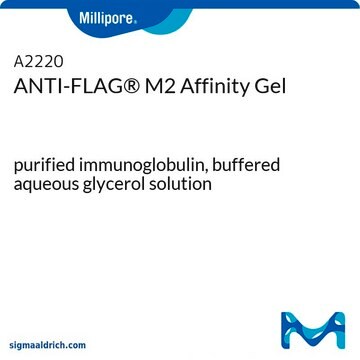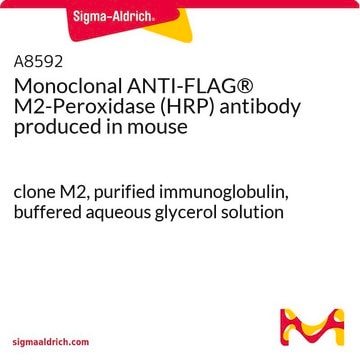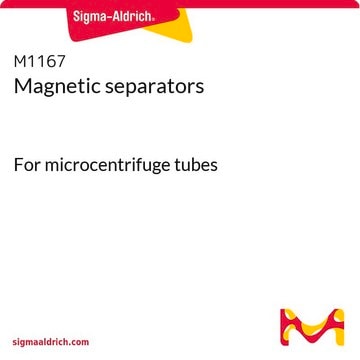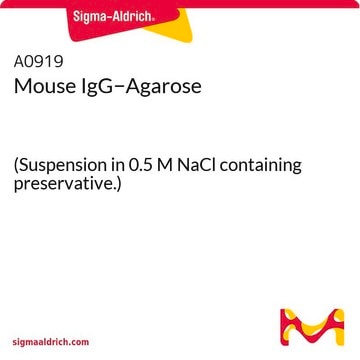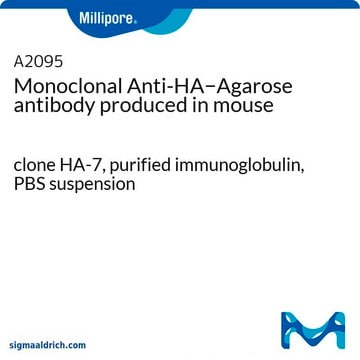The M2 Flag antibody is linked to the resin through a covalent linkage to one heavy chain. However, during the conjugation process, some Flag antibodies may also become bound to the resin through noncovalent attachments. To mitigate this, it is recommended to wash the resin using 0.1M Glycine followed by equilibration before use. This washing step ensures that the noncovalently linked antibodies are washed off. The protocol for this product can be found on the product page under more documents, where the Product Information sheet is available.
M8823
Esferas magnéticas Anti-FLAG® M2
affinity isolated antibody
Sinônimo(s):
ANTI-FLAG® M2 monoclonal, Resina FLAG® para alto rendimento, Resina de afinidade Flag®, Resina de afinidade magnética FLAG®, Anti-ddddk, Anti-dykddddk
Selecione um tamanho
Selecione um tamanho
About This Item
Produtos recomendados
conjugado
magnetic beads
Nível de qualidade
forma do anticorpo
affinity isolated antibody
tipo de produto de anticorpo
primary antibodies
clone
M2, monoclonal
Formulário
suspension
prazo de validade
2 yr at -20 °C
classe(s) química(is) do analito
proteins
técnica(s)
affinity chromatography: suitable
immunoprecipitation (IP): suitable
tamanho da esfera
20-75 μm
Matriz
superparamagnetic iron impregnated 4% agarose bead, with an average diameter of 50 μm.
Isotipo
IgG1
capacidade
≥0.6 mg/mL binding capacity
Condições de expedição
wet ice
temperatura de armazenamento
−20°C
Procurando produtos similares? Visita Guia de comparação de produtos
Descrição geral
Aplicação
Eluição - peptídeo FLAG®, glicina, pH 3,5, peptídeo FLAG® 3x
Saiba mais detalhes do produto em nosso portal de aplicações FLAG®.
Características e benefícios
- Separação muito rápida
- Manipulações significativamente aceleradas, como lavagens repetitivas
- Processamento de várias amostras realizado em formatos de placa
Possibilitando:
- Experimentação mais rápida
- Melhor reprodutibilidade
- Quantificação mais precisa das proteínas de interesse
forma física
Informações legais
Exoneração de responsabilidade
Não está encontrando o produto certo?
Experimente o nosso Ferramenta de seleção de produtos.
produto relacionado
Código de classe de armazenamento
12 - Non Combustible Liquids
Classe de risco de água (WGK)
WGK 1
Ponto de fulgor (°F)
Not applicable
Ponto de fulgor (°C)
Not applicable
Equipamento de proteção individual
Eyeshields, Gloves, multi-purpose combination respirator cartridge (US)
Escolha uma das versões mais recentes:
Certificados de análise (COA)
Não está vendo a versão correta?
Se precisar de uma versão específica, você pode procurar um certificado específico pelo número do lote ou da remessa.
Já possui este produto?
Encontre a documentação dos produtos que você adquiriu recentemente na biblioteca de documentos.
Os clientes também visualizaram
Artigos
The FLAG® Expression System is a proven method to express, purify and detect recombinant fusion proteins. Sigma®, the proven provider of FLAG®, now offers a magnetic bead for immunoprecipitation, protein purification, and the study of protein-protein interactions. The ANTI-FLAG® M2 Magnetic Bead is composed of murine derived, anti-FLAG® M2 monoclonal antibody attached to superparamagnetic iron impregated 4% agarose beads, with an average diameter of 50 µm. The M2 antibody is capable of binding to fusion proteins containing a FLAG peptide sequence at the N-terminus, Met-N-terminus, or C-terminus locations in mammalian, bacterial, and plant extracts.
Comparison of elution techniques for small-scale protein purification of FLAG® tag proteins using anti-FLAG® M2 magnetic beads.
Conteúdo relacionado
Protein purification techniques, reagents, and protocols for purifying recombinant proteins using methods including, ion-exchange, size-exclusion, and protein affinity chromatography.
Técnicas de purificação de proteínas, reagentes e protocolos para purificar proteínas recombinantes usando métodos que incluem cromatografia de troca iônica, cromatografia de exclusão por tamanho e cromatografia por afinidade a proteínas.
Protein expression technologies for various expression systems supporting research, therapeutics, and vaccine production.
Tecnologias de expressão de proteínas de diversos sistemas de expressão usados na produção de pesquisas, tratamentos e vacinas.
-
Bonjour Je souhaiterais que vous me confirmiez que les billes Billes magnétiques Anti-FLAG® M2 sont bien directement couplées à l'Anticorps anti flag ? Pouvez vous également me fournir un protocole d'immunocapture utilisant ces billes s'il vous plait ?
1 answer-
Helpful?
-
-
Which antibody is used to bind to the beads in Anti-FLAG® M2 Magnetic Beads(M8823) and EZview™ Red ANTI-FLAG® M2 Affinity Gel(F2426)? I have ordered the antibody(F1804 Monoclonal ANTI-FLAG® M2 antibody produced in mouse). Is it this one?
1 answer-
The antibody used for these items is proprietary information. ANTI-FLAG M2 Magnetic Beads consist of a mouse-derived, ANTI-FLAG M2 monoclonal antibody attached to superparamagnetic iron-impregnated 4% agarose beads. EZview Red ANTI-FLAG M2 Affinity Gel contains ANTI-FLAG M2 monoclonal antibody covalently attached to cross-linked 4% agarose beads. The ANTI-FLAG M2 antibody recognizes the FLAG octapeptide sequence (N-Asp-Tyr-Lys-Asp-Asp-Asp-Asp-Lys-C) at the N-terminus, Met-N-terminus, or C-terminus locations of a fusion protein.
Helpful?
-
-
Hello, I want to ask how many Flag-antibody on those beads?
1 answer-
The specific number of antibodies per bead is not determined. The minimum amount of antibody in this product is 2.5 mg/mL of suspension. A range of 1.7 - 2.1 mL of suspension will yield 1 mL of packed resin. Both of these values are lot specific and reported in the Certificate of Analysis. Please see the link below to review a sample or lot specific Certificate:
https://www.sigmaaldrich.com/product/sigma/m8823#product-documentationHelpful?
-
-
What is the maximum number of times that the ANTI-FLAG® M2 Magnetic Beads (M8823) can be reused?
What is the maximum number of times that the ANTI-FLAG® M2 Magnetic Beads (M8823) can be reused?
1 answer-
The maximum number of times that the ANTI-FLAG® M2 Magnetic Beads (M8823) can be reused varies depending on the specific sample applied. It can range from one to twenty uses. Factors such as the cleanliness of the sample and the presence of substances that may clog the resin or cause nonspecific binding can affect the number of reuses. In typical scenarios, the beads are commonly reused for 3-5 times. It is essential to refer to the technical bulletin for specific situations where the beads cannot be reused, such as when using reagents containing SDS: https://www.sigmaaldrich.com/deepweb/assets/sigmaaldrich/product/documents/187/075/m8823bul-ms.pdf
Helpful?
-
-
Is Product No. CL4B200, Sepharose® CL-4B a suitable alternative for a negative bead control if magnetic beads without FLAG are not available? Are there any other recommendations for this purpose?
1 answer-
For a negative control bead, any underivatized bead can essentially be used. While the Anti-FLAG® M2 Magnetic Beads (M8823) will work as a negative bead, it may not be suitable for magnetic applications. If a magnetic format is required, it is recommended to use polystyrene-based magnetized beads such as Product No. 49664, Micro particles based on polystyrene, magnetic. Alternatively, another option is to create a negative control using a non-FLAG tagged protein. This control can demonstrate the specificity of M8823 by showing its significant detection of FLAG-tagged proteins.
Helpful?
-
-
Does M8823 have the capability to detect internal FLAG tags in addition to N and C terminal sequences?
1 answer-
This paper (Zordan RE, Beliveau BJ, Trow JA, Craig NL, Cormack BP. Avoiding the ends: internal epitope tagging of proteins using transposon Tn7. Genetics. 2015 May;200(1):47-58. doi: 10.1534/genetics.114.169482. Epub 2015 Mar 5. PMID: 25745023; PMCID: PMC4423380) indicates that internal FLAG epiptopes were inserted into ORFs in yeast and detected by our F1804 antibody via Western blot. The biggest issue to overcome is the availability of the epitope for the antibody. If it is buried where it is not accessible in its native form, may not be possible. Denaturing the protein at least in this situation shows that the antibody can detect the protein.
Helpful?
-
-
Are the M2 antibodies on the Anti-FLAG® M2 Magnetic Beads covalently bound?
1 answer-
The M2 Flag antibody is linked to the resin through a covalent linkage to one heavy chain. However, during the conjugation process, some Flag antibodies may also become bound to the resin through noncovalent attachments. To mitigate this, it is recommended to wash the resin using 0.1M Glycine followed by equilibration before using it. This washing step ensures that the noncovalently linked antibodies are washed off.
Helpful?
-
-
Is there a protocol available for using the Anti-Flag M2 Magnetic Beads in a ChIP-Seq assay? Additionally, if the lysis buffer contains SDS and sodium deoxycholate at a concentration of 0.1%, will the presence of both denature or interfere with binding in the research process?
1 answer-
The use of Anti-Flag M2 Magnetic Beads in a ChIP-Seq assay has not been validated. However, according to a citation provided in Stem Cells (PMID: 31348575), it suggests that these beads are compatible for such applications. Please note that M8823 is not recommended for use with Sodium Dodecyl Sulfate (SDS) or deoxycholate, as these components can denature the immobilized antibody and disrupt its binding to FLAG fusion proteins.
Helpful?
-
-
Are there any problems with incubation at 40°C for this product?
1 answer-
The information you are requesting can be supplied by our Technical Service team who can assist you further. We kindly ask you to navigate to the link https://www.sigmaaldrich.com/techservice, and click on "Product Technical Inquires" under the Products Section with all the required information so that a member of our team can reach out to you to assist further. Thank you.
Helpful?
-
-
Dear all, I have a question regarding one of you product: Anti-FLAG® M2 Magnetic Beads, Cat. No: M8823. Is 0.1% SDS compatible with product binding FLAG peptide?
1 answer-
This product is not recommended for use with Sodium Dodecyl sulfate nor deoxycholate as they are known to denature the immobilized antibody and interfere with antibody binding to FLAG fusion protein.
Regarding reagent compatibility and protocol information, please see page 5 of the product technical bulletin at the link below:
https://www.sigmaaldrich.com/deepweb/assets/sigmaaldrich/product/documents/187/075/m8823bul-ms.pdfHelpful?
-
Active Filters
Nossa equipe de cientistas tem experiência em todas as áreas de pesquisa, incluindo Life Sciences, ciência de materiais, síntese química, cromatografia, química analítica e muitas outras.
Entre em contato com a assistência técnica